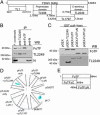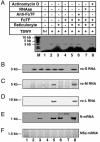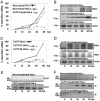Expression of a viral polymerase-bound host factor turns human cell lines permissive to a plant- and insect-infecting virus
- PMID: 15657123
- PMCID: PMC545839
- DOI: 10.1073/pnas.0406668102
Expression of a viral polymerase-bound host factor turns human cell lines permissive to a plant- and insect-infecting virus
Abstract
Tospoviruses are the only plant-infecting members of the Bunyaviridae family of ambisense ssRNA viruses. Tomato spotted wilt tospovirus (TSWV), the type-member, also causes mild infection on its main insect vector, Frankliniella occidentalis. Herein, we identified an F. occidentalis putative transcription factor (FoTF) that binds to the TSWV RNA-dependent RNA polymerase and to viral RNA. Using in vitro RNA synthesis assays, we show that addition of purified FoTF improves viral replication, but not transcription. Expression of FoTF deletion mutants, unable to bind the RNA-dependent RNA polymerase or viral RNA, blocks TSWV replication in F. occidentalis cells. Finally, expression of FoTF wild-type turns human cell lines permissive to TSWV replication. These data indicate that FoTF is a host factor required for TSWV replication in vitro and in vivo, provide an experimental system that could be used to compare molecular defense mechanisms in plant, insect, and human cells against the same pathogen (TSWV), and could lead to a better understanding of evolutionary processes of ambisense RNA viruses.
Figures





References
-
- Elliot, R. M. (1996) The Bunyaviridae (Plenum, New York).
-
- Sherwood, J. L., German, T. L., Whitfield, A. E., Moyer, J. W. & Ullman, D. E. (2001) in Encyclopedia for Plant Pathology, eds. Maloy, O. C. & Murray, T. D. (Wiley, New York), pp. 1034–1040.
-
- Ullman, D. E., Medeiros, R. B., Whitfield, A., Sherwood, J. L. & German, T. L. (2002) Adv. Bot. Res. 36, 113–140.
-
- de Hann, P., Kormelink, R., Resende, R. de O., Van Poelwijk, F., Peters, D. & Goldbach, R. (1991) J. Gen. Virol. 72, 2207–2216. - PubMed
Publication types
MeSH terms
Substances
Associated data
- Actions
LinkOut - more resources
Full Text Sources
Other Literature Sources

